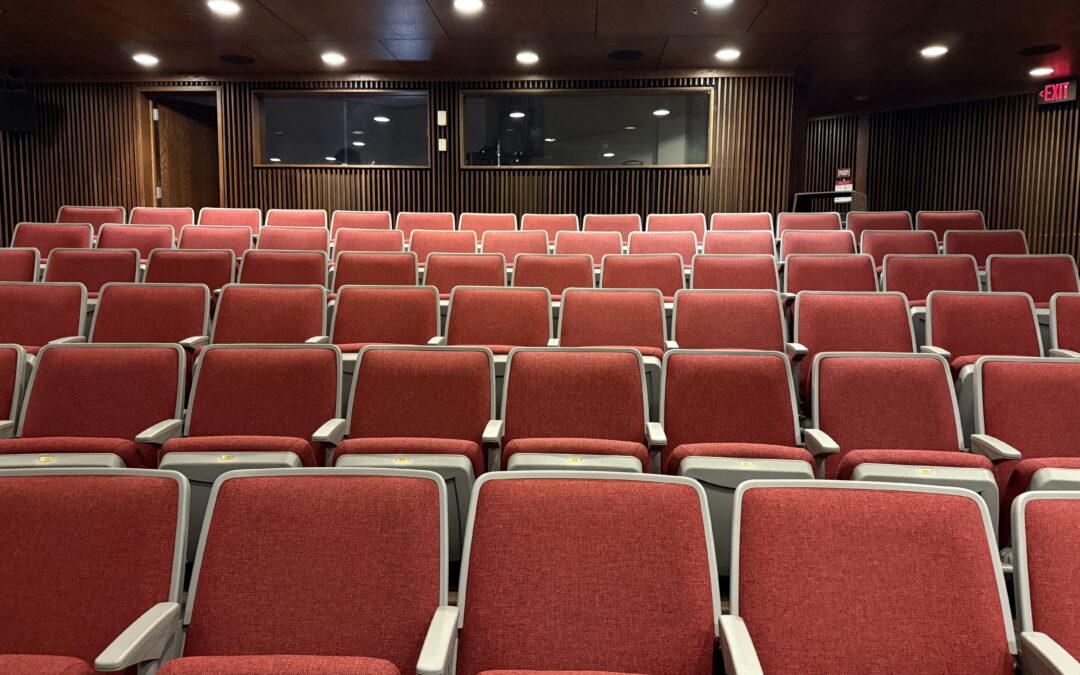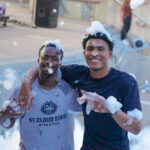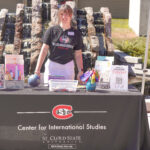Article by Olivia Simonson. Photo by Olivia Simonson.
On Tuesday, April 29, Professor Johansson and his creative writing class met for their final film showing of the semester. The group watched the 1991 film Point Break, starring Keanu Reeves and Patrick Swayze. The movie follows Johnny Utah, played by Reeves, as he tracks down and goes undercover among a group of surfers, searching for the group robbing banks across Los Angeles.
These film showings have occurred all semester for the class. While they are not mandatory, those in the class are encouraged to attend the showings in hopes of gaining a better understanding of narrative and characters. These lessons then can be applied to the student’s own fiction stories to help better their work.
“During the workshop for Advanced Fiction, we talk referentially about all media – but especially movies.” said Professor Johansson. “‘This part of your story reminds me of’ – and then we’d talk about narrative twists in Fight Club, or the question of unreliable narrators, or “how to write bad characters well” in Gone Girl. One of my students is an instructor at SCSU himself, and writes for television and film – both a past job of his, and a current side gig, and so we’d often turn to movies to reveal and discuss reactions to student creative work; it was an easy shorthand…until we found that many of our film references hadn’t been seen by the students.”
The other instructor that runs these film showings is Professor Thury, who received his film degree from SCSU a couple of years ago. He is a current graduate student in Professor Johansson’s class alongside teaching his own courses at SCSU. Once they found some students hadn’t see these films, the idea for the film nights began. When it came to choosing what films to show, there was much discussion before a list was selected.
“We decided to switch off every other week, as he has films he loves for the story (among other reasons as well), and I have films I love for the cinematic value (as well as other reasons too), and this lends to a deep and verbose look at an eclectic selection of films.” said Thury. “Most importantly though, is that they are cult favorite films that somehow most of the students he and I teach have not seen. We began with the classic Fight Club, then followed with Gone Girl, then The Departed, and we will conclude this semester with Point Break (the original Swayze film).”
Afterwards, students discuss different topics that are relevant to the movie. For Point Break, students discussed why certain characters and relationships worked, along with other elements, such as the composition of the movie and how it impacted films made afterwards.
“An important aspect of these movie nights – as important as viewing the movies – is the discussion we have afterwards.” said Johansson. “Because of time limits, we’ve only been able to talk about these movies immediately afterwards, for about 25-30 minutes, but for me, this is the most fun aspect of the exercise; we talk about general reactions – viewer feedback to the watching of the movies, timely considerations – if we’re watching North by Northwest, made in 1958, we might discuss how what was important to consider, as a storyteller, or how modes or methods of speaking and communicating would necessarily be different for an author and an audience in 1958, would necessarily be different than it is today, and how that would change the stories we tell if they’re set in 1958 – or any time other than our own – and this leads us into more discussion about how we set, describe, and populate our stories. There’s also just a lot of good, productive discussion of our experience of the movies – and what they’re trying to tell us – or could be trying to tell us, and how they do that, successfully or not; basically, how we start each student workshop, by asking: what are we noticing, what are we liking, what are we remembering about this story? And eventually – what would improve this story in its next draft?”
Similar to the movies, Johansson host his class in a workshop style – where students sit in a circle and read one piece of work, discussing what worked and did not work in a students draft. Students are encouraged to write a variety of stories, even if they don’t fit into the typical academic setting. Students write stories in genres such as fantasy and sci-fi, and the class keeps an open mind – something that Johansson hasn’t always seen at other universities.
“I’ve been in workshops for pieces of Fantasy (and SciFi, rarely), and have heard instructors (full professors at important universities) ask: ‘Why would you ever want to write a story with a dragon in it?’ When I’ve submitted stories to workshop in my grad career that included minor elements of Fantasy or Science Fiction, I’ve been told ‘I wish you would have written a normal story for us to consider – because this one doesn’t show me you can write.'” said Johansson. “This doesn’t happen in my workshops. When we find elements of Fantasy or other genre work in stories, we discuss it like any other consideration of storycraft: ‘If you’re going to include dragons in the story, you have to be aware of the tropes of dragons, and decide: are you going to work with that trope – to confirm and use what we already know about dragons, dragon-culture, and behavior, or are you going to work against that trope – to surprise us, and subvert our expectations of what-dragons-do?'”
While the semester is wrapping up, the two professors hope to continue the tradition next year.
“We’re already talking about what films we want to show and in what order.” said Thury. “Hopefully it goes for a while with us and even keeps going after we’re gone. SCSU used to have a film showcase like this, but it’s been a while since then. So it’s important to us that this stays and keeps going, even if it is in the sometimes wacky and zany way we do things!”






Recent Comments